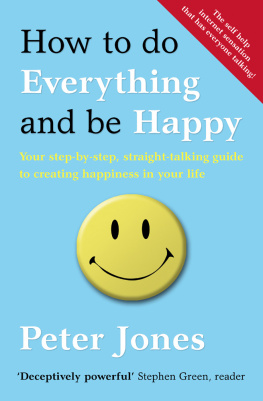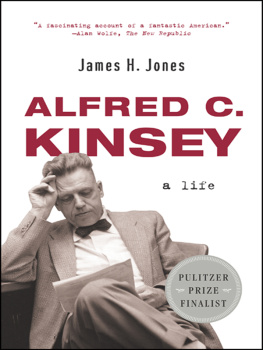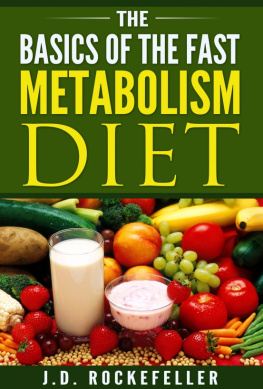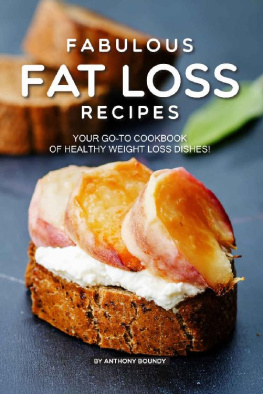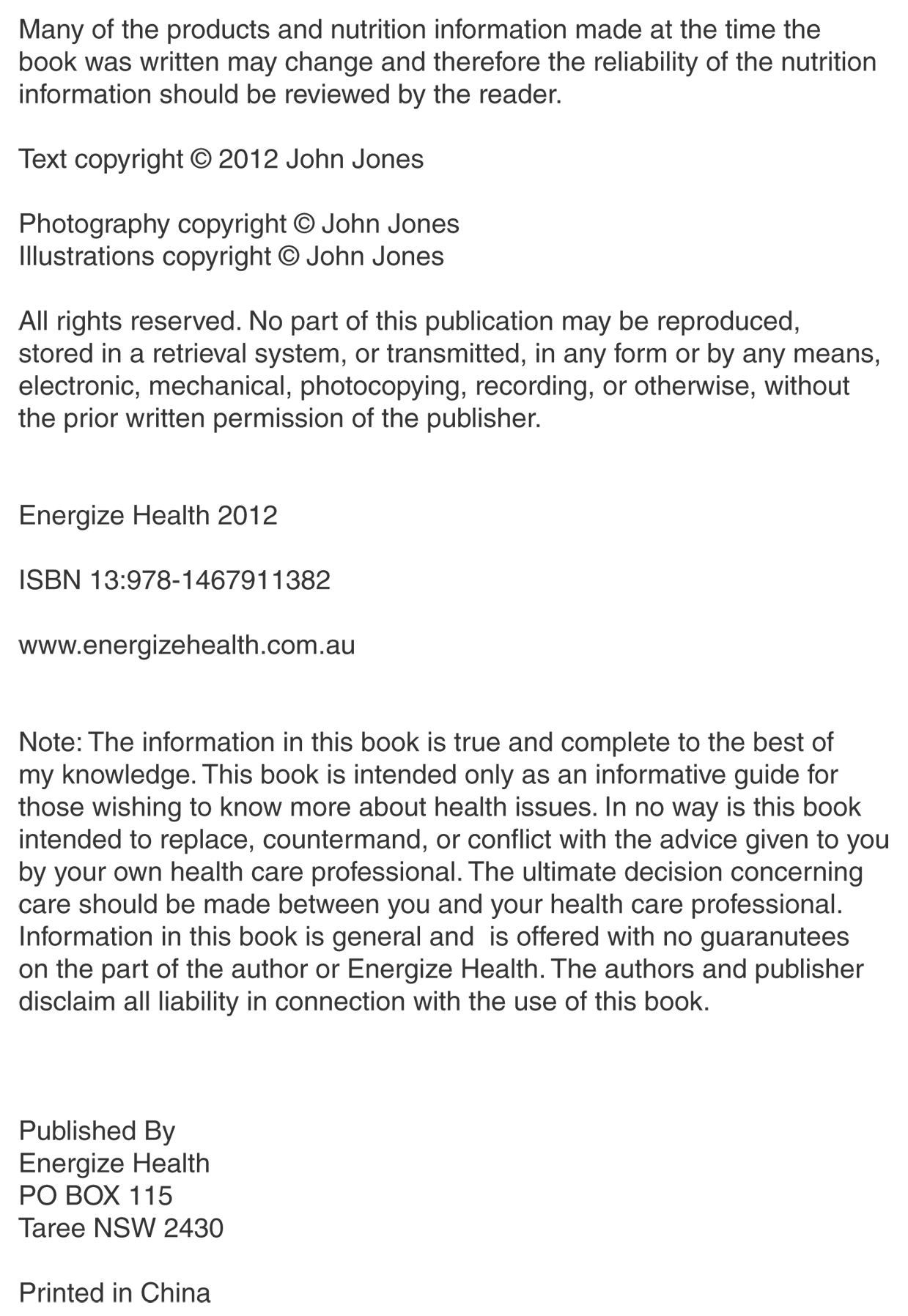Acknowledgements
This book is the result of helping almost 10,000 people lose weight and improve their health.
To my wife, Id like to personally thank you for your support, encouragement and inspiration. You have always believed in me, and you are my best friend and greatest fan. I love you.
To my children, thank you for your patience and the time that youve waited just another five minutes while Dad finishes this sentence. You bring a smile to my face and have continued to be the motivation to just get on with it. You are the best.
To my parents, who have always believed in me and demonstrated that if you stick with something youll get there. Im thankful for your words of reassurance when it seems like things are not working.
To my mum, especially, who has been my longest client. Dont give up, and use each experience as an opportunity to learn something. Youve given me a wealth of information and have been a willing guinea pig.
To my brothers and their family, thanks for your support and the fun times we share. Youre all champions.
To the Doctors who have supported me and put your trust in me to provide your patients with advice and guidance. Thanks for letting me make mistakes.
To all the staff and health professionals at the medical centres and hospitals where I have worked. It has always been lots of fun working with you, and I hope you have enjoyed it as much as I have.
To my colleagues who have shared a wealth of information and taken time to read through my book and provide valuable feedback and advice. Your help is greatly appreciated.
Lastly, to my clients, from whom Ive learnt more than I have taught. You have shared your lifes story with me and allowed me to speak words of advice that I hope will give you the gift of good health!
To the people who are reading this book, learn to believe in yourself and dont let past failures stop you from picking yourself up and getting on with it. I know that if you take the time to practice the principles in this book, you will benefit from a lifetime of good health and well-being.
This book is written for you!
Welcome to the start of your journey. Losing weight begins with a few small steps, and long-term weight loss is all about changing the way you think, how you eat and when you move. Any successful weight-loss program should control your hunger, manage cravings, improve metabolism and promote a sense of well-being.
People who lose weight eventually regain most of the weight they have lost. Your emphasis should be on adopting lifestyle habits that have been successfully used by people who have lost weight and kept it off.
Being overweight is the result of eating too much, however it can also result from a slower metabolism, and it is one of the reasons why weight gain is so common. The thermogenic effect can improve your metabolism and this book will give you the tools you need lose weight.
To reduce your weight by 1kg with physical activity alone, it would take a 100km walk, yes 100 kilometres. However controlling your calorie intake and using, with the thermogenic effect, its possible to get similar results by making small changes to how you eat.
In order to help you maintain your weight loss, we need to identify the factors that have caused you to gain weight. Lack of sleep, stress, eating out, poor food choices, confusion with food labels, eating too quickly and many other circumstances can lead you to gain weight.
The first phase of this process is to discover the lifestyle factors that have led to your weight gain. The second phase is about redesigning your lifestyle so that it supports your decision to lose weight. Third, maintaining your weight loss is about learning how to overcome bad habits so you succeed.
All great journeys start with the first step.
1 Step OneWhere am I now?
In order for you to start moving forward, you need to discover what is standing in your way. This phase involves identifying barriers and finding the motivation to make a positive lifestyle change.
2 Step TwoWhere do I want to be?
Creating a picture of the person you want to be can be a powerful motivational tool. This is where you set goals and establish milestones to come up with a roadmap for where you are going.
3 Step ThreeHow am I going to get there?
The next step is to develop a plan of attack. In this phase, you will learn about the way food affects your body and how to choose the right foods so you take off weight. The thermogenic effect can help increase your metabolism and give you the kick-start you need to slim down.
4 Step FourCreating habits to stay at your goal!
Long-term weight loss is about adopting successful habits from people who have maintained their weight loss. During this phase, we will learn the secrets of people who have maintained significant weight loss, so that you can do the same.
THMTake-Home Message
Long-term weight loss is about adopting successful habits from people who have maintained their weight loss. During this phase, we will learn the secrets of people who have maintained significant weight loss, so that you can do the same!
Chapter 1
What is thermogenesis?
Our body isnt a perfect engine.
Take-Home Message
1. Processed food promotes weight gain
2. Unhealthy weight loss can lead to weight regain
3. The thermogenic effect can speed up your weight loss.
What is the thermogenic effect?
We have always been told that the weight-loss equation is simple. Its energy in versus energy out. In other words, its your calorie or kilojoule intake from the food you eat compared to the energy you burn. But what happens in-between? Is a calorie a calorie, or are certain foods more likely to make you gain weight?
The thermogenic effect is the heat created in the process of digesting food. As you eat, the food must go through a number of steps to break down, become absorbed, and metabolised. Effectively, it is the combustion process that our body undertakes when digesting food, a little like how the engine in your car works.
The first law of thermodynamics states that energy can neither be created nor destroyed, only changed from one vessel to another. Our bodys energy is constantly being transformed from one state to another. We can change sugar to fat, and protein to sugar, along with many other processes.
The problem is that our body is not a perfect engine. The energy produced from the combustion of a food is not the same as the amount of energy that is available to our body. This is the concept of metabolisable energy, or the difference between the energy from the food we eat and the energy left after digestion and metabolism.
Two scientists in the early twentieth century measured the energy produced by many different foods. Max Rubner and Wilbur Atwater found that there were differences in the energy left from fats, carbohydrate, protein and fibre after digestion.
Rubner estimated that the loss of energy from the protein breakdown in the body was 23%. His work started to reveal the thermogenic effect from food and that a calorie is not exactly a calorie. He showed that, as humans, our bodies do not use all the calories available from the breakdown of a food.
Not until recently have we started to look at the effect of thermogenesis on weight loss.
To understand how the thermogenic effect can help, you need to know how the energy in food is calculated. The methods used to estimate the calories in food are based on a number of assumptions.


